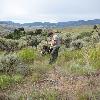A decision support prioritization framework for non-indigenous plant population management
Management of both non-indigenous plant species (NIS) and endangered rare plants species (RPS) is a high priority in many managed forests, wildlands and rangeland areas. However, public or private agencies rarely have sufficient resources to manage all NIS or conserve all RPS. In many cases more effort is placed on NIS than RPS, but the shared goal is to manage both NIS and RPS more effectively and efficiently. Therefore, we are creating a structured decision making framework as part of an adaptive management approach. The framework consists of four interconnected phases: definition of land management/use goals, an articulation of NIS or RPS objectives, surveying, monitoring, and evaluation, and prioritization(/optimization) of management actions followed by management evaluation.
Details of the conceptual prioritization framework can be found in Rew et al., (2007). The research component aims to expedite the NIS population management prioritization process by circumventing or streamlining steps currently within the monitoring phase, and improving our decision support simulation model to incorporate habitat suitability, population demographics, detection probability and economic trade-offs. To achieve this we are collecting data on populations of four different NIS established along environmental suitability gradients. The aim of the extension component is to ensure that not only do we reach a large audience with our web-based interactive prioritization framework but that the concepts and model will be widely adopted.
Click on an image to view as a slideshow.







